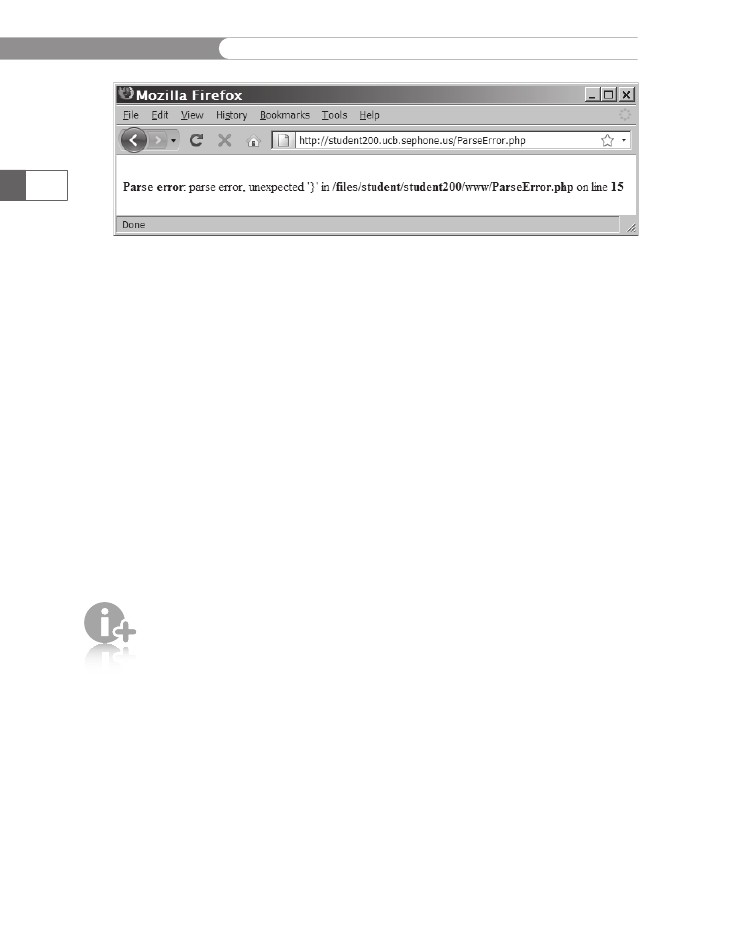
- •Initializing with Constructor Functions . . . . .
- •Into a Web page as a separate section. Although JavaScript code can
- •Is that standard php script delimiters are guaranteed to be available
- •In the block. Any text or lines between the opening /* characters and
- •2.7541 Are not integers; they are floating-point numbers. A floating-
- •Value 300
- •Is a value of 2.5, because 6 goes into 15 exactly 2.5 times. But if you
- •IsEven.Php.
- •Ing example,
- •Ing curly brace is on its own line following the function statements.
- •In php 3 and earlier, it was necessary to put a function definition
- •Is called an iteration. When the conditional expression evaluates
- •Including Files
- •13. Close your Web browser window.
- •Including Files
- •In php, you can also use two operators to combine strings. The first
- •Xhtml source code gen-
- •Input. Php provides several functions for manipulating the case of a
- •Is uppercase. If you need the reverse of ucfirst(), the lcfirst()
- •In some situations, you will need to find and extract characters and
- •Information Interchange, or ascii, which are numeric represen-
- •In comparison, the following preg_match() function returns a value
- •In the pattern is optional. The following code demonstrates how to
- •Values; any strings you validate against a regular expression must
- •Value of 1 because the top-level domain contains a valid value of .Com.
- •Is submitted using the “post” method, the form data is embedded in
- •Validating String Data
- •Xhtml tags or character entities. The message field is a text string
- •Value of the header element. For example:
- •Xhtml code within a php script section.
- •Is typically the person who created the resource. Otherwise, the net-
- •If even a single character of the Web page is sent prior to sending
- •Variables to the file_put_contents() function.
- •Xhtml hyperlink. To download a file from outside the xhtml
- •If...Else statement to display the appropriate version of the mes-
- •Iterating Through an Array
- •Iterating Through an Array
- •In Chapter 2, you learned how to use a foreach statement to iterate
- •Iterating Through an Array
- •Iterating Through an Array
- •In comparison, the following code declares and initializes
- •If ((!file_exists("MessageBoard/messages.Txt"))
- •Values from the array to create a thumbnail gallery of images in which
- •Introduction to Databases
- •Including php, allow you to create Web pages that can read and write
- •Introduction to Databases
- •Information that can be organized into ordered sets of data, and
- •Information. Each recipe in a recipe database, for instance, is a single
- •Introduction to Databases
- •Index, which identifies records in a database to make retrievals and
- •In a single table. However, you might want to break the information
- •Into multiple tables to better organize it into logical sets. Another
- •Information in one of the tables confidential and accessible only by
- •Is the employee information table from Figure 7-1. The related table
- •Is a payroll table that contains confidential salary and compensation
- •Information. Notice that each table contains an identical number of
- •Introduction to Databases
- •Introduction to Databases
- •In a junction
- •Introduction to Databases
- •In a relational format is called a relational database management
- •Is a standard data manipulation language among many dbmSs.
- •Into the query area at the top of the screen or by dragging tables and
- •It is important to understand that even though many dbmSs sup-
- •Introduction to Databases
- •If you ever
- •Is. In comparison, the bigint data type stores integer values between
- •5 Rows in set (0.00 sec)
- •Int);[enter ]
- •Important, these two tabs can cause you to lose all of the data in the
- •Internet Explorer to export the table, click the Save button in the File
- •Ifies the table being changed and the change to make.
- •It easier for you to write php code that can be used with a variety of
- •Information about queries that match one of the following formats:
- •Various types of actions, depending on the type of query.
- •Include fields for the date and time of the flight, flight number, and
- •In the ChineseZodiac folder and upload the file to the server. Open
- •Including white space,
- •Information on a Web server. When you start a new session, the
- •Introduction to Object-Oriented Programming
- •Introduction to Object-Oriented
- •Variables associated with an object are called properties or attributes.
- •In the Loan object example, a function that calculates the number of
- •Introduction to Object-Oriented Programming
- •Introduction to Object-Oriented Programming
- •Include instances of objects inherit the object’s functionality.
- •In this chapter, you will create the Web site for an online order form
- •In an online store application. The application includes information
- •Ity of building a working online store. Online store classes are very
- •Information and products. The OnlineStore class requires that store
- •Information is stored in a table containing six fields: storeId, name,
- •Information. Instead, the class simply uses session iDs to keep track
- •Variable and function as necessary, without bothering with all this
- •In a class
- •Is developed. Imagine what would happen if Microsoft distributed
- •Ing class is invalid because it does not include an access specifier:
- •If they will not be supported by future xhtml versions or are not
- •Xhtml standards. To review the guide of current w3c css specifi-
- •Information to remind yourself or others of what the code is doing. A
- •Xhtml document to the external style sheet. This link informa-
- •If you select Apache from the WampServer menu and select Service
- •Ing code uses the number_format() function to add comma separa-
- •In data that a user submits to a php script.
- •Value of “On” and the display_startup_errors directive is assigned
- •Instead. By looking at the source code, you could see that the value of
- •Ing engine can even help locate logic errors.
- •In Chapter 8, along with the equivalent mssql_* functions, where
- •Inline styles, 632
- •Xhtml, 620–635 (continued)
The php.ini configuration file contains two directives,
display_errors and display_startup_errors, that determine
whether error messages are displayed in a Web browser. The
display_errors directive displays script error messages, whereas the
display_startup_errors directive displays errors that occur when
PHP starts. By default, the display_errors directive is assigned a
Value of “On” and the display_startup_errors directive is assigned
a value of “Off.” Although displaying error messages is useful when
you develop PHP scripts, the PHP Group strongly recommends that
you turn off the feature for scripts that run in production environ-
ments and save any errors in a log file instead. Hackers can use any
displayed error messages to identify potential weaknesses in your
Web site. The PHP Group also recommends that you only turn on the
display_startup_errors directive when debugging a script.
APPENDIX
Error
Handling
and
Debugging
Regardless
of their experience, knowledge, and ability, all program-
mers
introduce errors into their programs. Thus, they must devote
part
of their programming education to mastering the art of debug-
ging.
As you learned at the beginning of this book, debugging is the
act
of tracing and resolving errors in a program. Debugging is an
essential
skill for any programmer, regardless of the programming
language.
E
Determining
the Error Type
Three
basic types of errors can occur in a program: syntax errors,
run-time
errors, and logic errors.
Syntax
Errors
Syntax
errors,
or parse
errors,
occur when the PHP scripting
engine
fails to recognize code. Syntax errors can be caused by incor-
rect
use of PHP code, misspelled words, or references to objects,
methods,
and variables that do not exist. For example, if a program-
mer
omits a method’s closing parenthesis, the scripting engine
generates
a syntax error. As another example, the statement ehco
"<p>Hello
World!</p>"; causes
a syntax error because echo
is
misspelled.
Similarly, the following statements cause a syntax error
because
the $Hello
variable
is incorrectly typed with a lowercase ‘h’.
(Remember
that identifiers in PHP are case sensitive.)
APPENDIX
E
Syntax
errors in
compiled
languages,
such as
C++, are also called
compile-time errors
because they are usually
discovered when a pro-
gram is compiled.
Because PHP is an inter-
preted language, syntax
errors are not discovered
until a program executes.
$Hello = "<p>Hello World!</p>\n";
echo $hello;
Run-Time Errors
A run-time error occurs when the PHP scripting engine encounters
code it cannot execute while the rest of the program is executing.
Run-time errors differ from syntax errors in that they do not neces-
sarily represent PHP language errors. For example, consider the state-
ment customFunction();, which calls a custom PHP function named
customFunction(). This statement does not generate a syntax error
because it is legal (and usually necessary) to create and then call cus-
tom functions in a PHP program. However, if your program includes
the call statement but does not include code that creates the function
in the first place, your program generates a run-time error. The error
occurs when the scripting engine attempts to call the function but
cannot find it.
The following code shows another example of a run-time error. In
this example, an echo statement attempts to display the contents of a
variable named $MessageVar, which is set by calling the user-defined
function GetMessageString(). Because the function is not declared
anywhere in the document, a run-time error occurs.
<?php
$MessageVar = GetMessageString();
echo $MessageVar;
?>
656
When investigating a run-time error, keep in mind that the culprit
might actually be a syntax error. Because syntax errors do not occur
until the scripting engine attempts to execute the code, they often
manifest as run-time errors. For example, suppose your code includes
a function that contains a statement with a syntax error. This syntax
error will not be caught until the function executes at run time.
Logic Errors
A logic error is a flaw in a program’s design that prevents the pro-
gram from running as you anticipate. In this context, “logic” refers to
the execution of program statements and procedures in the correct
order to produce the desired results.
One common logic error is the creation of an infinite loop, in which a
loop statement never ends because its conditional expression is never
updated or is never FALSE. For example, the following code creates an
infinite loop because the third argument in the for statement’s paren-
theses never changes the value of the $Count variable:
APPENDIX
E
for
($Count = 10; $Count >= 0; $Count) {
if
($Count == 0)
echo "<p>We have liftoff!</p>\n";
else
echo "<p>Liftoff in $Count seconds.</p>\n";
}
Because the $Count variable is never updated in the preceding exam-
ple, it continues to have a value of 10 through each iteration of the
loop, and “Liftoff in 10 seconds” is repeatedly displayed in a browser
window. To correct this logic error, you add a decrement operator to
the third argument in the for statement’s constructor, as follows:
for ($Count = 10; $Count >= 0; --$Count) {
if ($Count == 0)
echo "<p>We have liftoff!</p>\n";
else
echo "<p>Liftoff in $Count seconds.</p>\n";
}
657
Handling and Reporting Errors
The first line of defense in locating PHP program bugs are the error
messages you receive when the PHP scripting engine encounters an
error. PHP generates four basic types of errors: parse errors, fatal
errors, notices, and warnings. Parse errors are syntax errors, whereas
the other three types are run-time errors.
Parse error messages occur when a PHP script contains a syntax
error that prevents your script from running. For example, the fol-
lowing code raises a parse error because the for() statement is miss-
ing its opening brace ({). Figure E-1 shows the resulting parse error
message in a Web browser.
<?php
for ($Count = 10; $Count >= 0; --$Count)
if ($Count == 0)
echo "<p>We have liftoff!</p>\n";
else
echo "<p>Liftoff in $Count seconds.</p>\n";
}
?>

APPENDIX
E
658
Figure
E-1
A
parse error message
Two
important pieces of information are displayed with a parse error:
the
line number in the document where the error occurred and a
description
of the error. Note that the line number in an error mes-
sage
is counted from the start of the document, not just from the start
of
a script section.
Keep
in mind that error messages only indicate the general location
of
an error in a program, not the exact nature of an error. You cannot
assume
that the line specified by an error message is the actual prob-
lem.
The parse error message in Figure E-1 indicates that the error
occurred
on line 15, because the PHP scripting engine searches to the
end
of the script for the for()
statement’s
opening brace. However,
the
real problem is that the opening brace should be the first charac-
ter
following the closing parenthesis in the for()
statement’s
condi-
tional
expression.
Fatal
error messages are
raised when a script contains a run-time
error
that prevents it from executing. A typical fatal error message
occurs
when a script attempts to call a function that does not exist.
Warning
and
notice mes-
sages may
be sup-
pressed in
your PHP configuration.
The next section explains
how to enable them to
help you debug your
code.
Warning messages are raised for run-time errors that do not prevent
a script from executing. For example, a warning message occurs when
you attempt to divide a number by 0, or if you pass the wrong num-
ber of arguments to a function.
Notice messages are raised for potential run-time errors that do not
prevent a script from executing. Notices are less severe than warnings
and are typically raised when a script attempts to use an undeclared
variable.

APPENDIX
E
Configuring
the Way PHP
Displays
Errors
The
php.ini configuration file contains various directives that
control
how
the PHP scripting engine handles errors. PHP also includes vari-
ous
functions that you can use to control error handling at run time.
659
Displaying
Errors in the Web Browser
The
php.ini configuration file contains two directives, print_errors
and
print_startup_errors,
which determine whether error mes-
sages
are displayed in a Web browser. The print_errors
directive
displays
script error messages, whereas the print_startup_errors
directive
displays errors that occur when PHP first starts. By
default,
the print_errors
directive
is assigned a value of “On,” and
the
print_startup_errors
directive
is assigned a value of “Off.”
Although
displaying error messages is useful when you develop PHP
scripts,
the PHP Group strongly recommends that you turn this fea-
ture
off for scripts that run in production environments, and instead
save
any errors in a log file. Hackers can use any displayed error mes-
sages
to identify potential weaknesses in your Web site, so the PHP
Group
also recommends that you only turn on the print_startup_
errors
directive
when debugging a script.
One
piece of
information
that is avail-
able to hack-
ers is shown
in Figure E-1. The error
message shows the loca-
tion of the file in the serv-
er’s directory structure
and exposes the underly-
ing directory structure to
visitors.
Setting the Error Reporting Level
The error_reporting directive in the php.ini configuration file deter-
mines which types of error messages PHP should generate. Setting
the error reporting level can be useful in helping you debug your
scripts. However, keep in mind that changing the error messages
generated by PHP does not prevent errors from occurring; it only
prevents the error messages from being displayed in the Web browser
or written to a log file.
By default, the error_reporting directive is assigned a value of
E_ALL, which displays all errors, warnings, and notices in the Web
browser. You can also assign the directive the error levels listed in
Table E-1. Note that each error level can be set using either the con-
stant or integer listed in the table.

APPENDIX
E
Constant
E_ERROR
E_WARNING
Integer
Description
0
1
2
4
8
16
32
64
256
512
1024
2047
2048
Turns
off all error reporting
Reports
fatal run-time errors
Reports
run-time warnings
Reports
syntax errors
Reports
run-time notices
Reports
fatal errors that occur when PHP first starts
Reports
warnings generated by the Zend Scripting Engine
Reports
errors generated by the Zend Scripting Engine
Reports
user-generated error messages
Reports
user-generated warnings
Reports
user-generated notices
Reports
errors, warnings, and notices, with the exception
of
E_STRICT notices
Reports
strict notices, which are code recommendations
that
ensure compatibility with PHP 5
660
E_PARSE
E_NOTICE
E_CORE_ERROR
E_COMPILE_WARNING
E_COMPILE_ERROR
E_USER_ERROR
E_USER_WARNING
E_USER_NOTICE
E_ALL
E_STRICT
Table
E-1
Error
reporting levels
To
generate a combination of error levels, separate the levels assigned
to
the error_reporting
directive
with the bitwise Or
operator
(|). For
example,
the following statement specifies that PHP will only report
fatal
and parse errors:
error_reporting
= E_ERROR | E_PARSE
The
bitwise
Xor
operator
(^)
can be
used
in place
of
the &~.
To
specify that the E_ALL
error
should exclude certain types of mes-
sages,
separate the levels with bitwise And
(&)
and Not
operators
(~).
The
following statement specifies that PHP should report all errors
except
run-time notices:
error_reporting
= E_ALL &~ E_NOTICE
Instead
of modifying the values assigned to the error_reporting
directive
in the php.ini configuration file, you can use the error_
reporting()
function
to specify the messages to report in a particu-
lar
script. Use the same bitwise operators to separate reporting levels
that
you pass to the error_reporting()
function.
The following
statement
uses the error_reporting()
function
so that PHP only
reports
fatal and parse errors:
error_reporting(E_ERROR
| E_PARSE);
The
following statement uses the error_reporting()
function
to
specify
that PHP should report all errors except run-time notices:
error_reporting(E_ALL
&~ E_NOTICE);
APPENDIX
E
To
disable error messages for a particular script, place the error_
reporting()
function
at the beginning of a script section and pass to
it
a value of 0, as follows:
error_reporting(0);
Logging
Errors to a File
Remember
that for security reasons, you should disable the display of
error
messages for any scripts that run in a production environment.
Unless
you work for a large company with separate development
and
production systems, you will probably use the same server to
execute
scripts in development and to execute scripts in production.
In
this situation, it’s not feasible to use your php.ini configuration
file
to
enable and disable the print_errors
and
print_startup_errors
directives
each time you want to work on a script. A better choice is
to
log all errors to a text file.
PHP
logs errors to a text file according to the error reporting level
assigned
to the error_reporting
directive
in the php.ini configura-
tion
file, or the level that you set for an individual script with the
error_reporting()
function.
The php.ini configuration file includes
several
parameters for handling error logging, including the log_
errors
and
error_log
directives.
The log_errors
directive
deter-
mines
whether PHP logs errors to a file; it is assigned a default value
of
“Off.” The error_log
directive
identifies the text file where PHP
will
log errors. You can assign either a path and filename or syslog
to
the error_log
directive.
On UNIX and Linux systems, a value of
syslog
specifies
that PHP should use the syslog
protocol
to forward
the
message to the system log file. On Windows systems, a value of
syslog
forwards
messages to the Event Log service.
The
E_ALL
level does not
include the
E_STRICT
level. The
E_STRICT level always
needs to be explicitly
included.
661
Using Basic Debugging Techniques
Although error messages are valuable because they point out prob-
lems with your scripts, they cannot always help you identify the
source of a problem. This section discusses basic debugging tech-
niques that can help you locate problems in your PHP scripts.
Tracing Errors with echo Statements
When you cannot locate a bug in your program by using error mes-
sages or examining your code, or if you suspect a logic error (which
would not generate an error message), you must trace your code.
Tracing is the examination of individual statements in an executing

APPENDIX
E
If
you place
echo state-
ments in a
program to
trace a prob-
lem, place them at a dif-
ferent level of indentation
than other statements to
distinguish them from the
actual program.
662
program. The echo statement provides one of the most useful ways
to trace PHP code. You place an echo statement at different points in
your program and use it to display the contents of a variable or the
value returned from a function. An echo statement is especially useful
when you want to trace a bug in your program by analyzing a list of
values. Using this technique, you can monitor values as they change
during program execution. To trace the problem, you can place an
echo statement at the point in the program where you think the error
might be located.
If your program has multiple functions and functions calling func-
tions, it is often useful to insert echo statements that display
Entering function() and Leaving function() at the beginning
and end of each function, respectively. For functions that take input
parameters, it may help to display the values of the parameters in the
Entering function() string. For functions that return a value, it may
be helpful to display the return value, as in Leaving function(),
returning X. This will allow you to see when each function is called,
what values are passed, when each function returns, and what values
are returned.
When the main script or a function contains a long series of state-
ments, and you know that one of the statements is failing, you might
be able to find the culprit by adding an echo statement that displays
a simple sequence count between each statement, as in the following
code segment:
...
CustomFunctionA();
echo "<p>Step 5</p>\n";
CustomFunctionB();
echo "<p>Step 6</p>\n";
CustomFunctionC();
...
For arrays,
you can
use the
print_r()
function or the
var_dump() function in
place of the echo
statement.
If the Web browser displays “Step 5” but does not display “Step 6”,
then you know that CustomFunctionB() is causing the script to fail.
Using Comments to Locate Bugs
Another method of locating bugs in a PHP program is to transform
lines that might be causing problems into comments. In other words,
you can “comment out” problematic lines. This technique helps you
isolate the statement that is causing the error. In some cases, you
can comment out individual lines that might be causing an error, or
you can comment out all lines except the ones that you know work.
When you first receive an error message, start by commenting out
only the statement specified by the line number in the error message.

APPENDIX
E
Save
the script, and then open it again in your Web browser to see if
you
receive another error. If you receive additional error messages,
comment
out those statements as well. After you eliminate the error
messages,
examine the statements you’ve commented out to find the
cause
of the bug.
Often,
you will see the error immediately and not need to comment
out
code or use any other tracing technique. However, after you stare
at
the same code for a long time, simple spelling errors are not always
easy
to spot. Commenting out lines that you know are causing trouble
is
a good technique for isolating and correcting even the simplest
bugs.
Do
not com-
ment out
statements
that span
multiple
lines or
statements on a line that
contains an opening or
closing brace. This intro-
duces further parsing
errors into your code.
The cause of
an error in a
particular
statement is
often the
result of an error in a
preceding line of code.
663
Analyzing Logic
At times, errors in PHP code stem from logic problems that are dif-
ficult to spot using tracing techniques. When you suspect that your
code contains logic errors, you must analyze each statement for
errors. For example, the following code contains a logic flaw that
prevents it from functioning correctly:
if (!isset($_POST['firstName']))
echo "<p>You must enter your first name!</p>\n";
exit();
echo "<p>Welcome to my Web site, " .
$_POST['firstName'] . "!</p>\n";
If you were to execute the preceding code, you would never
see the last echo statement, even if a value were assigned to the
$_POST['firstName'] variable. If you examine the if statement more
closely, you will see that it ends after it executes the echo statement.
The exit() statement following the variable declaration is not part
of the if structure, because the if statement does not include a
set of braces to enclose the lines it executes when the conditional
evaluation returns true. For this reason, the exit() statement
always executes, even when the user correctly assigns a value to the
$_POST['firstName'] variable. For the code to execute properly, the
if statement must include braces as follows:
if (!isset($_POST['firstName'])) {
echo "<p>You must enter your first name!</p>\n";
exit();
}
echo "<p>Welcome to my Web site, " .
$_POST['firstName'] . "!</p>\n";
The following for statement shows another example of an easily
overlooked logic error:
for ($Count = 1; $Count < 6; ++$Count);
echo "$Count<br />\n";
APPENDIX
E
664
The
preceding code should display the numbers 1 through 5 on
the
screen. However, the line for
($Count = 1; $Count < 6;
++$Count);
contains
an ending semicolon, which marks the end of
the
for
loop.
The loop executes five times and changes the value of
count
to
6, but does nothing else because there are no statements
before
its ending semicolon. The line echo
"$Count<br />\n"; is
a
separate
statement that executes only once, displaying the number 6
on
the screen. The code is syntactically correct, but does not function
as
you anticipated. As you can see from these examples, it is easy to
overlook
very minor logic errors in your code.
Formatting
Code
It
is much easier to review your code and analyze your logic by ensur-
ing
that your code is properly formatted. By indenting your code
properly
and using standard formatting for nested code blocks, you
can
often locate a missing closing brace or a scope issue.
Commenting
Code
Sometimes
it is difficult to tell what a particular section of code is
supposed
to do. By commenting those sections with a description
of
the intended function, you can avoid trying to figure out what the
code
is supposed to do and concentrate on verifying that the code
will
accomplish what you intended. Comments also assist in marking
context
switches,
in which your script stops doing one task and starts
another.
Examining
Your Code
When
you use an editor like Notepad++, the editor automatically col-
or-codes
your source code based on the file extension. This helps you
track
down many types of syntax errors. For example, if the code after
a
block comment is the same color as the block comment, you prob-
ably
did not include the closing */
for
the block comment. Another
common
error is accidentally mixing opening and closing quotation
marks,
such as using a single quotation mark at the beginning of a
string
and a double quotation mark at the end of the string. When
this
error occurs, the text will appear in the color used to highlight
strings
until another single quotation mark occurs.
Examining
the Script Output
The
purpose of a PHP script is to generate XHTML code that is inter-
preted
and displayed by a Web browser. When debugging, it is usually
better
to see the actual XHTML code generated by the PHP script
